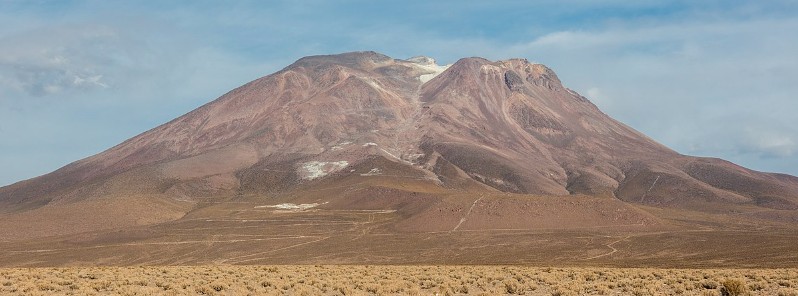Monitoring stations installed in the vicinity of the massive Ollagüe stratovolcano in the Andes, on the border between Bolivia and Chile, detected increased seismicity under the volcano on January 2, 2023.
- No historical eruptions have been recorded at this volcano
- Activity at this volcano has been restricted to periods of intense fumarolic activity, and a persistent steam plume emanates from a fumarole on the south side of the summit dome
- The Alert Level remains at Green
Ollagüe monitoring stations detected an M3.0 earthquake at a depth of 2.3 km (1.4 miles) at 08:07 LT (11:07 UTC) on January 2, 2023.
Analysis of the event showed this was a volcano-tectonic earthquake, associated with rock fracturing caused by the movement of magma beneath the surface of the Earth.
Four other similar events were recorded but of lower energy.
No significant changes are observed in the seismic behavior of the volcano, ONEMI said in a report issued at 12:39 UTC today.1
Currently, the volcano is in constant degassing at 560 m (1 837 feet) above the point of emission. This outgassing is not directly related to the aforementioned event.
There is no evidence of volcanic ash in webcam and satellite imagery, Buenos Aires VAAC reported at 12:05 UTC.
SERNAGEOMIN continues the permanent surveillance of the volcano online and the Regional Directorate of SENAPRED will maintain coordination with the members of the Regional Disaster Prevention and Response System to alert in a timely manner and provide an adequate response to eventual emergency situations resulting from the volcanic condition.
Geological summary
Volcán Ollagüe, also known as Oyahué, is a massive andesitic stratovolcano with a summit dacitic lava dome.
A large Pleistocene debris-avalanche deposit extending westward separates the Salar de San Martín from the Salar de Ollagüe.
Three youthful-looking silicic lava flows mark late post-collapse eruptions, but show evidence of glaciation and are thought to pre-date the last glacial advance at about 11 000 years ago (Freeley et al., 1993).
A youthful-looking scoria cone on the lower WSW flank, La Poruñita, was initially considered to be of Holocene age (González-Ferrán, 1995), however, Wörner et al. (2000) later obtained Potassium-Argon dates of 420 000 to 680 000 years.
Active sulfur mines on the upper western and southern flanks are reached by a road that climbs to about 5 500 m (18 044 feet) elevation.
No historical eruptions have been recorded; activity has been restricted to periods of intense fumarolic activity, and a persistent steam plume emanates from a fumarole on the south side of the summit dome.2
1 Activity monitoring of the Ollagüe volcano – Commune of Ollagüe – ONEMI – January 2, 2022
2 Ollagüe – Geological summary – GVP

